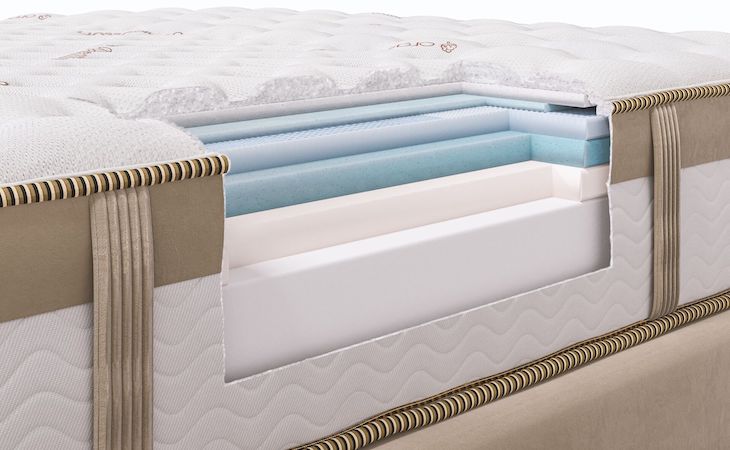If you’re in the market for a new memory foam mattress (or any kind of foam mattress), one of the most important factors to consider is foam density.
Foam density affects many essential properties of the mattress, such as its pressure relief abilities and durability. In general, the higher the foam density, the more comfortable, supportive, and long-lasting the mattress will be.
How is foam density measured—and what density mattress do you need for your best sleep? Read on to find out.
What does foam density mean?
In general, density is a measurement of weight per unit of volume. Foam density is exactly what it sounds like. It’s the mass of a foam’s cells relative to its volume.
Foam density is measured in all types of foam mattresses, including memory foam and polyfoam. Density can range from low (less weight per unit of volume) to high (more weight per unit of volume).
How is foam density measured?
A foam’s density is measured in pounds per cubic foot (PCF) and is determined by measuring the weight of a single cubic foot of foam. It’s done by dividing the entire weight of a foam layer by its volume.
For instance, if a layer of foam weighs 100 pounds and measures 25 cubic feet in volume, its density can be determined by dividing that total weight by the total number of cubic feet. In this case, 100 divided by 25 is 4 pounds per cubic foot (4 PCF).
Generally, foam density can range from 1.5 PCF to more than 5 PCF, with the measurements toward the bottom range being “low-density” and those toward the high range “high-density.”
But to make matters a bit more complicated, what’s considered “high-density” and “low-density” varies depending on the type of foam.
The density range is much lower for polyfoam than for memory foam, and what’s considered “high-density” is different for these two types of foam. The reason for this is the different structure of each type of foam.
The cells of memory foam are generally closer together than the cells of polyfoam. For that reason, memory foam that’s considered low-density is still going to have a higher PCF than polyfoam that’s labeled high-density.
Consult the table below for the average foam density of memory foam and polyfoam:
Foam Density Memory Foam Polyfoam Low-density < 3 PCF < 1.5 PCF Medium-density 3-5 PCF 1.5-1.7 PCF High-density > 5 PCF > 1.7 PCF
How does foam density affect mattress performance?
Foam density directly influences such important factors as the mattress’s pressure relief abilities, durability, and temperature neutrality.
Pressure relief
Pressure relief is the mattress’s ability to evenly distribute the weight of the sleeper, preventing the creation of pressure points (points where certain parts of your body—specifically shoulders and hips—bear more weight than the rest of your body).
Pressure relief is closely tied to foam density in foam mattresses. Higher-density foam generally conforms to your body closer than lower-density foam. Therefore, high-density foam usually offers better pressure relief.
Durability
Because it has more foam cells per cubic foot, higher-density foam tends to be more durable than lower-density foam. So if you’re looking for a mattress that will last you for years to come, it’s best to choose one made with high-density foam.
Keep in mind that most bed in a box mattresses are made with low-density foam so they can be compressed and stuffed in a box. Typically, these mattresses will only last you for a handful of years. Learn more about the biggest mattress in a box problems.
Temperature neutrality
Lower-density foams can sometimes offer better temperature regulation than higher-density foams. That’s because the higher a foam’s density, the less space there is between foam cells for air to circulate.
This might be an important consideration for people who tend to sleep hot and those living in warmer climates. That said, many newer foam mattresses do contain cooling properties.
Mattress weight
Density directly affects the weight of the mattress. The higher the density, the heavier the mattress (because there’s more foam material per cubic foot). Premium memory foam mattresses often weigh upwards of 100 pounds. Take this into account if you plan to move your mattress often.
Price
The higher the density of the foam, the more costly it is to produce. So mattresses that contain layers of higher-density foams tend to be more expensive than those with lower-density foams.
What’s the ideal foam density for a mattress?
Although it’s not an exact science, the general rule of thumb is that the higher the foam density, the higher the quality of the mattress. Look for foam density of at least 3 pounds per cubic foot. Premium memory foam has a density of 4 to 5 pounds per cubic foot.
FAQs
Does foam density affect the firmness of your mattress?
Generally, the denser the foam, the firmer the mattress will feel. But the firmness of the overall mattress depends on several factors and is influenced by its entire structure—not just the top layer that your body comes in contact with. Most mattresses consist of several layers, all of which contribute to the overall firmness.
For instance, a mattress with a soft lower-density comfort layer may feel firmer or softer depending on what support layers are used in it. The support core can be a denser layer of foam, a different type of foam, or a layer of coil springs in a hybrid mattress.
That’s why when evaluating mattress firmness, it’s not enough to know the density of the foams used in it. Choose a brand that offers a generous trial period to make sure that the mattress’s firmness level and overall feel are right for you.
Find a high-quality memory foam mattress at Saatva
Saatva offers a variety of handcrafted mattresses, including a

The most luxurious memory foam with adaptive cooling & body-hugging support
made with layers of high-density foam that provide excellent pressure relief and support for your back.
All of Saatva’s mattresses come with a 365-night home trial and a lifetime warranty so you can try one out before deciding if it’s right for you. Take our mattress quiz to find your perfect match.





